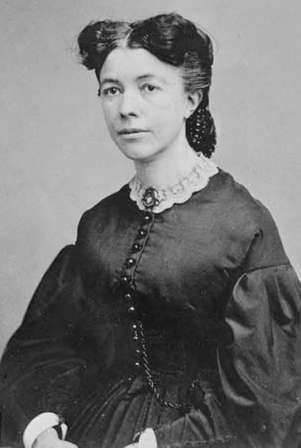“Mary Booth is as good a friend as ever.”
Lavinia Goodell, April 26, 1866
When Lavinia Goodell went to work for the newly minted Harper’s Bazar magazine in 1867 (read about her experiences here and here), she worked with and shared an office with Bazar’s editor, Mary Louise Booth, one of the best known and best paid women in publishing.

Mary Booth was born on Long Island in 1831. She displayed great literary tendencies at an early age and was naturally inclined toward the study of languages. By the time she was 20, she had begun translating foreign literary works into English. In 1859 she published A Complete History of the City of New York, which received rave reviews, and later published two revised editions. During the Civil War, Mary Booth translated Gasparin’s The Uprising of a Great People in the course of a week during which she worked round the clock. President Lincoln wrote her a letter of thanks for her help in strengthening the spirit of the American people.
It is not known how or when the Goodell family first met Mary Booth, but according to family letters they had made her acquaintance by the late 1850s. In September 1859, Lavinia wrote to her parents reporting that she had visited Mary, seen her History of New York, and was very impressed with it. “It is very handsomely got up. The author’s name on the title page looks quite imposing, and I begin to think myself ‘some pumpkins’ to be an intimate of so literary a lady.” In 1861, when well known abolitionist and long time Goodell family friend Gerrit Smith gave Lavinia $5.00 to spend on books, Mary Booth offered Lavinia advice on where she could get books at a good price. In 1862, Lavinia wrote to her sister Maria reporting that Mary Booth was translating a new book on the war, from French and said, “She didn’t waste much time trying to catch beaux! I do like that girl!”
In Lavinia’s early days at Harper’s Bazar, she and Mary Booth got along quite companionably, but by early 1868 their personal relationship had cooled. Lavinia’s mother wrote to Maria Frost:
You will perceive that Lavinia and Mary Booth are not as congenial as formerly. What the matter really is, I cannot exactly learn. I think her position makes her feel big. She has had a good deal of attention on account of her literary attainments. I think she is a little jealous that the Harpers pay so much attention to Lavinia & doesn’t have implicit confidence in her work.
In May of 1868, Lavinia wrote to her parents:
Mary’s selfishness does not make me supremely wretched, so long as I have the kind friendship of the Harpers. I thin they see thro her, in some things, and I know who they like best…. I sometimes think as you do that she is jealous of me.
Nonetheless, the two women continued to work together congenially at Harper’s until Lavinia moved to Janesville in the fall of 1871.

In the cold winter of 1871, Lavinia reported to her parents:
I have devised a method for having warm drink at the office at noon. I have bought a little gas kettle in which I can cook chocolate over the gas. Mary Booth is so well pleased with the idea that she has made a compact with me; she to furnish all the materials if I will make enough for us both.
Mary Booth remained the editor of Harper’s Bazar until her death in March of 1889. Shortly before her death a New York newspaper ran a short item saying that Mary was reported to be the best salaried woman journalist in the country, receiving $5,000 a year for her work. Mary’s New York Times obituary said:
She displayed a remarkable faculty for recognizing buried talent, and many of the now famous women writers of the country owe it to Mary Booth that the budding talent they displayed was encouraged and nurtured into blossoming…. Her house has always been a Mecca for literary people. Her Saturday evenings have for years been famous, as in her parlors gathered artists, authors, statesmen, and the gifted of all professions.
Sources consulted: Lavinia Goodell’s letters to Maria Frost (February 4, 1862; April 26, 1866); Lavinia Goodell’s letters to William and Clarissa Goodell (September 27, 1859; May 11, 1868; February 12, 1871) Clarissa Goodell’s letter to Maria Frost (February 20, 1868); New York Times (March 6, 1889); Our Famous Women, an Authorized Record of Their Lives and Deeds, A. D. Worthington & Co., Hartford, Conn., 1884; Tricia Foley, Mary L. Booth, the Story of an Extraordinary 19th Century Woman, (2018); The Evening World (Jan. 15, 1889); Eugene Exman, The House of Harper (Harper Perennial 2010)







